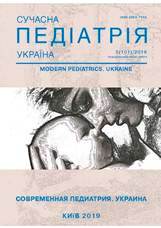Differential diagnosis of arthritis in children
Abstract
Arthritis in children develops not only in patients with rheumatic diseases. Many somatic disorders make their debut with arthritis or arthralgia as a non-speсific manifestation of the disease. Arthritis can be a manifestation of some rare genetic diseases. The child is not yet able to express his or her complaints which makes the diagnosing process more complicated. The key to correct diagnosis is clinical examination. This article describes basic principles of clinical examination and diagnosis of arthritis in children as well as diseases that cause them in most cases, such as rheumatic, oncological, genetic, and metabolic. Differential diagnosis is a way to rationally analyze the diseases, which manifest themselves with arthritis. The course of the disease is to be analyzed the following way: differential diagnosis of diseases with persisting arthritis; differential diagnosis of diseases, which manifest themselves with arthritis and are associated with different manifestations in organs and systems; non0inflammatory arthritis or joint pain. Joint inflammation, which lasts for over 6 weeks, is considered to be persistent or cronic arthritis. It may be caused by different diseases associated with infection, neoplastic processes, inflammatory diseases or sarcoidosis. Oncological and septic arthritis are so called red flag diseases, which need to be treated immediately. The most common cause of inflammatory arthritis in children is juvenile idiopatic arthritis. Arthritis of unknown origin in children under the age of 18 that lasts for over 6 weeks is a reason for diagnosing juvenile idiopathic arthritis. The diseases which manifest themselves with arthritis and are associated with manifestation in different organs and systems are systemic juvenile idiopatihc arthritis, systemic autoimmune diseases and autoinflammatory diseases. 10–20% of children have complaints about cronic or reoccurring non0inflammatory muscle and bone pain. It is most commonly caused by joint hypermobility as a consequence of excessive movement range and is often observed in healthy children. The term joint hypermobility syndrome is used when joint hypermobility occurs and is accompanied by muscle and joint pain that have no other cause. Growing pains are observed in 6% to 49.4% of children in the age of 4 to 14 years. Timely diagnosis of disease caused by arthritis, makes it possible to assign the correct treatment.References
Albuhairan I, Al-Mayouf SM. (2013). Camptodactyly-coxavara-pericarditis syndrome in Saudi Arabia: Clinical and molecular genetic findings in 22 patients Semin Arthritis Rheum. 43: 292—296. https://doi.org/10.1016/j.semarthrit.2012.11.004; PMid:23290693
Botton E, Saraux A, Laselve H, Jousse S, Le Goff P. (2003). Musculoskeletal manifestations in cystic fibrosis. Joint Bone Spine. 70: 327—335. https://doi.org/10.1016/S1297-319X(03)00063-0
Bussone G, Mouthon L. (2009). Autoimmune manifestations in primary immune deficiencies. Autoimmun Rev. 8(4): 332—336. https://doi.org/10.1016/j.autrev.2008.11.004; PMid:19028607
Esposito S, Bosis S, Sabatini C, Tagliaferri L, Principi N. (2013). Borrelia burgdorferi infection and Lyme disease in children. Int J Infect Dis. 17: e153-e158. https://doi.org/10.1016/j.ijid.2012.09.014; PMid:23141587
Gewitz MH, Baltimore RS, Tani LY, Sable CA, Shulman ST, Carapetis J et al.; American Heart Association Committee on Rheumatic Fever, Endocarditis, and Kawasaki Disease of the Council on Cardiovascular Disease in the Young. (2015). Revision of the Jones Criteria for the diagnosis of acute rheumatic fever in the era of Doppler echocardiography: a scientific statement from the American Heart Association. Circulation. 131(20): 1806—1818. https://doi.org/10.1161/CIR.0000000000000205; PMid:25908771
Grahame R, Bird HA, Child A. (2000). The revised (Brighton 1998) criteria for the diagnosis of benign joint hypermobility syndrome (BJHS). J Rheumatol. 27(7): 1777—1779.
Ibba S, Piga M, Congia M, Cauli A, Mathieu A. (2016). Pachidermoperiostosis as a cause of massive joint effusion with polyarticular involvement mimicking juvenile idiopathic arthritis: A case report. Joint Bone Spine. 83(1): 113—114. https://doi.org/10.1016/j.jbspin.2015.03.001; PMid:26184532
Krause K, Feist E, Maurer M, Kallinich T. (2011). Cryopyrin-assoziierte periodische Syndrome (CAPS) — Prototypen autoinflammatorischer Erkrankungen. Kinder- und Jugendmedizin. 6: 349—357. https://doi.org/10.1055/s-0038-1629166
Lowe RM, Hashkes PJ. (2008). Growing pains: a noninflammatory pain syndrome of early Childhood. Nat Clin Pract Rheumatol. 4(10): 542—549. https://doi.org/10.1038/ncprheum0903; PMid:18762787
McErlane F, Gillon C, Irvine T, Davidson JE, Casson D, Dalzell AM, Beresford MW. (2008). Arthopathy in paediatric inflammatory bowel disease: a cross-sectional observational study. Rheumatol. 47: 1251—1252. https://doi.org/10.1093/rheumatology/ken217; PMid:18550638
Milner D, Fasth A, Etzioni A. (2008). Autoimmunity in severe combined immunodeficiency (SCID): lessons from patients and experimental models. J Clin Immunol. 28: S29—S33. https://doi.org/10.1007/s10875-007-9159-y; PMid:18193342
Morishita K, Petty RE. (2011). Musculoskeletal manifestations of mucopolysaccharidoses. Rheum (Oxford). 50(5): v19—25. https://doi.org/10.1093/rheumatology/ker397; PMid:22210666
Petty RE, Laxer RM, Lindsley CB, Wedderburn LR. (2015). Textbook of pediatric rheumatology, 7th edn. Philadelphia: Saunders: 739.
Rose CD, Wouters CH, Meiorin S, Doyle TM, Davey MP, Rosenbaum JT, Martin TM. (2006). Pediatric granulomatous arthritis: an international registry. Arthritis Rheum. 54: 3337—3344. https://doi.org/10.1002/art.22122; PMid:17009307
Viswanathan V, Khubchandani RP. (2008). Joint hypermobility and growing pains in children. Clin Exp Rheumatol. 26(5): 962—966.
Downloads
Issue
Section
License
The policy of the Journal “MODERN PEDIATRICS. UKRAINE” is compatible with the vast majority of funders' of open access and self-archiving policies. The journal provides immediate open access route being convinced that everyone – not only scientists - can benefit from research results, and publishes articles exclusively under open access distribution, with a Creative Commons Attribution-Noncommercial 4.0 international license (СС BY-NC).
Authors transfer the copyright to the Journal “MODERN PEDIATRICS. UKRAINE” when the manuscript is accepted for publication. Authors declare that this manuscript has not been published nor is under simultaneous consideration for publication elsewhere. After publication, the articles become freely available on-line to the public.
Readers have the right to use, distribute, and reproduce articles in any medium, provided the articles and the journal are properly cited.
The use of published materials for commercial purposes is strongly prohibited.

